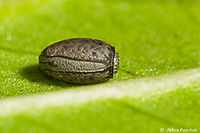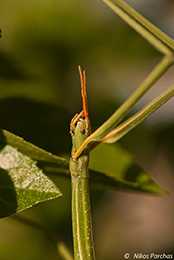Bacillus atticus atticus
 The glyphs on the eggs, are very distinguishable | ||||||||||||||||||||||||||||
Bacillus atticus atticus is a species of phasmid which lives only in Greece. It is often called "The walking stick" due to its camouflage imitation. It can often be found climbing on plants and can be kept as a pet in an insectarium.
Description
Adults have a slim body about 80 mm long, with a stripe on each side. Their antennae are red and short. The forelegs are strong, around 50 mm long, painted red at their base.
Behaviour
Bacillus atticus atticus[1] is mostly active at night, when it feeds. The usual foods of this species are plants such as ivy and lettuce. During the day, the animal stays absolutely still, camouflaged as a stick, matching the color of the plant that it's on. If disturbed, its main defense is to feign death. Like many phasmids it is parthenogenetic so it can reproduce on its own by laying eggs. The eggs are ovoid-shaped with some distinguishable glyphics around them and a sponge-like shape on the top.
Living in captivity
Right now there are no living colonies in captivity. However, they can be kept in cages around 25x25 cm with a simple paper foil at the bottom. They have to be sprayed with clean water at least twice a day and they can be fed with leaves of lettuce and other groceries.[2]
See also
- Bacillus rossius, the endemic Bacillus of Western Mediterranean Europe
References
External links
 Media related to Bacillus atticus at Wikimedia Commons
Media related to Bacillus atticus at Wikimedia Commons- Bacillus atticus atticus at mchportal.com
